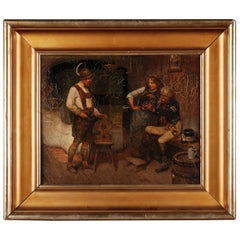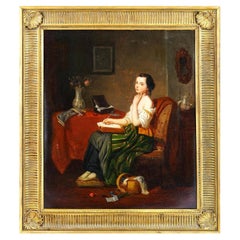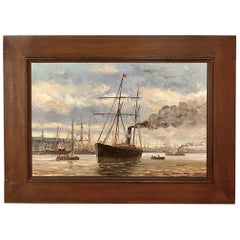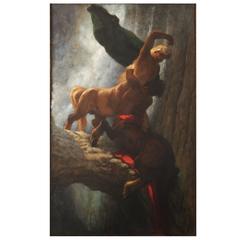Maximilian Wachsmuth Furniture
to
1
1
1
1
1
1
1
1
1
1
1
7,546
3,967
2,548
2,244
Creator: Maximilian Wachsmuth
19th Century Oil Painting by M. Wachsmuth, 1859-1912
By Maximilian Wachsmuth
Located in Berlin, DE
Oil on canvas. Scene in a upper Bavarian economy. Signed Maximilian Wachsmuth.
(S-102).
Category
19th Century German Antique Maximilian Wachsmuth Furniture
Materials
Canvas
Related Items
19th Century Continental Figurative Oil Painting
Located in New York, NY
Antique (19th century) oil painting on canvas depicting a seated woman glancing toward the view, penning a letter. Mounted in a period giltwood frame, 32 x 27 7/8 inches. Apparentl...
Category
Late 19th Century Antique Maximilian Wachsmuth Furniture
Materials
Canvas
19th Century Framed Oil Painting on Canvas by A. Jaboneau
Located in Dallas, TX
This 19th century framed oil painting on canvas by Albert Jaboneau (1855-?) depicts the bustling harbor scene at Anvers, France during the late 19th century showing the "hybrid" ship...
Category
1880s French Aesthetic Movement Antique Maximilian Wachsmuth Furniture
Materials
Canvas
Dutch 19th Century Oil Painting
Located in Atlanta, GA
A very handsome late 19th century Dutch Oil On Canvas Painting by Ed. Jacobs housed in its ebonized frame depicting a marine scene with many sailing ships.
Category
Late 19th Century Dutch Antique Maximilian Wachsmuth Furniture
Materials
Canvas
19th Century Oil on Canvas Painting
Located in Dublin, IE
A gorgeous 19th Century oil on canvas painting depicting a figural pastoral scene featuring a shepherd with his dog and flock of sheep within an exquisite mountain landscape with lus...
Category
19th Century English Antique Maximilian Wachsmuth Furniture
Materials
Canvas, Giltwood, Paint
Mid 19th Century Oil Painting Dogs by Joseph Stevens
By Joseph Stevens
Located in Casteren, Noord-Brabant
An oil painting of two rustic dogs fighting over a piece of food. It is painted on an oak panel. Signed top left. The signature is a bit faded, it's a monogram J.S. by Joseph Stevens. He often signed with a monogram. In a gilded frame frame with gesso moldings.
Dimensions frame: 41 x 47 cm
Dimensions painting: 17 x 23 cm.
Joseph Stevens is the older brother of the very well-known artist Alfred Stevens. In the book 'The Belgian Art Book' by J. de Geest, it is written that Joseph Stevens has given a new dimension to painting animals. Joseph Stevens is an early representative of realism and social art. While Eugene Verboeckhoven has royal dogs pose on a beautifully embroidered cushion, Joseph Stevens already has an eye for the dark side of animal existence: exploitation by man, who in turn is a victim of society. His first successful painting, Brussels in the morning, shows how miserable dogs and poor people suffer the same fate. In the Sandman, Stevens shows a joint effort of man and dog, in which the viewer cannot ignore the social conditions: exhausting labor at dawn in some suburb. The gray sky and monochromy of the suburb add to the sinister atmosphere. Joseph Stevens was one of the first artists to take the urban proletariat as his subject. Stevens enjoys a very high reputation in his Parisian years. His brother Alfred writes: 'I am of this time, but you, Joseph, you are of the race, and thus you are of all times.' French critics agree. Stevens' works are a source of inspiration for the literature of the time. For example, Beaudelaire writes a poem about Stevens' dogs.
Joseph Edouard STEVENS. Belgium, 1819-1892
Stevens was a painter, etcher and engraver. Brother of the gifted painter Afred Stevens. Education at the Academy in Brussels (1834-1835). Debuted at the Salon in Brussels in 1842. Continued his career in Paris in 1852. He was primarily the painter of canvases depicting domestic animals (dogs, monkeys, horses), sometimes in curious, even idiosyncratic situations, and far from romanticism. This realism, of which he was one of the pioneers, earned him the interest of critics and intellectuals.
His approach was defined by this contemporary realism that eschewed idealized depictions of animals as heroic emblems of nobility. Rather, Stevens emphasized the ordinary animals of everyday life, with a particular focus on working dogs, stray dogs and all of the mutts that wandered the streets of Brussels. Museums and public collections, including' Royal Museum of Fine Arts Brussels, Ghent, Hamburg, Paris, Musée du Louvre, Rouen, Musee des Beaux-Arts. Stuttgart, State Gallery. King Leopold...
Category
1850s Belgian Beaux Arts Antique Maximilian Wachsmuth Furniture
Materials
Gesso, Oak, Pine, Paint
19th Century Oil on Canvas Painting by Rose Douglas
Located in Dublin, IE
A gorgeous 19th Century oil on canvas painting depicting a figurative maritime scene featuring a group of sailors, fishermen, women and children on a pier set amongst dwellings, sail...
Category
19th Century English Antique Maximilian Wachsmuth Furniture
Materials
Canvas, Giltwood, Paint
19th Century English Marine Oil Painting
Located in Shipston-On-Stour, GB
A nicely executed mid C19th British School oil on canvas, depicting a clipper vessel named ‘Jennie’, with other vessels and cliffs of Dover in the background, and realistic seas. Set...
Category
1850s English Country Antique Maximilian Wachsmuth Furniture
Materials
Canvas, Giltwood, Paint
19th Century Impressionistic Oil Painting by Pierre Georges Jeanniot
By Pierre Georges Jeanniot
Located in Casteren, Noord-Brabant
Impressionist painting by the Swiss painter Jeanniot. It is oil on a mahogany panel, the painting is signed in the lower left and dated 1884.
On the back is a label, presumably stuck on it by a previous owner, with information about the painter.
The painting has an Art Nouveau frame, woodwork with stucco, gilded and decorated with typical Art Nouveau flowers.
Top left and top right are minor damages to the frame. See pictures.
Jeanniot is a fairly well-known Swiss painter who was friends with the famous French painter Edgar degas. Below you will find more information about the painter Jeanniot.
Pierre-Georges Jeanniot
Switzerland, 1848-1934
The artistic education of Pierre Georges Jeanniot began with his father, Pierre-alexander Jeanniot (1826–1892), a longtime director of l’École des Beaux-arts of Dijon, France. Nevertheless, Pierre-Georges Jeanniot started out pursuing a military career, as an infantry officer (1866–1881), but he never ceased drawing. He was known for the first time in 1872 at the art exhibition salon de Paris, where he presented a watercolor painting called 'intérieur de forêt'.
The next year he presented the painting 'Le Vernan à nass- sous-Sainte-anne'. From then on he was a regular contributor to the salon de Paris, where he presented new works with views of Toulouse, Paris, Troyes, the edges of the seine, and some portraits. In 1881, after the army offered him the rank of commandant, he resigned to devote himself exclusively to painting. He took up residence in Paris. His works from this period represent mainly scenes of military life that allowed him to forge a reputation. Jeanniot established himself permanently in 1882 and obtained his first award the following year (medal third class of the Salon de Paris).
From then on, he started to show a certain artistic independence. He then mostly portrayed Parisian women during the “Belle Époque”, women in bathing suits...
Category
1880s French Romantic Antique Maximilian Wachsmuth Furniture
Materials
Paint
English 19th Century Oil Painting
Located in Stockbridge, GA
English 19th century oil painting.
Category
Late 19th Century English Antique Maximilian Wachsmuth Furniture
Materials
Wood
Antique Waterscape Oil Painting by William Dommersen 19th Century
Located in London, GB
A beautiful waterscape painting " A view on the Amstel " by William Raymond Dommersen (British, 1859-1927) Signed, Signed with initials, and Inscribed on reverse, late 19th Century in date.
The painting has a captivating illuminating light with beautiful vibrant colours, it depicta a busy waterway with fishing and sailing boats in the foreground and the town of Amsterdam in the back ground.
William Raymond Dommersen was a painter of genre and landscapes in and around Scotland and Northern England. His works are widely exhibited throughout the European and North American continents and are on show at many galleries worldwide.
William travelled quite extensively in Europe on painting expeditions with his father
Dommersen’s paintings have been much admired over a period of time and it is evident that he is now firmly established in the history of architectural painting as is refelected in the auction prices at Christies:
Nineth century European Art: 12 September 2007, London South Kensington, Lot 29 £4,750
The Arthur Ackermann and Peter Johnson Collection: 8 May 2008, London, South Kensington, Lot 42, £4,000
Old Masters and 19th Century Art 9 November 2010, Amsterdam, Lot 110 £5,250
Nineth century European Art: 28 April 2010, London South Kensington, Lot 221 £5,250
Condition:
In really superb condition the painting and frame having been beautifully cleaned, please see photos for confirmation.
Dimensions in cm:
Height 59 x Width 50 x Depth 7 - Frame
Height 34 x Width 44 x Depth 7 - Canvas
Dimensions in inches:
Height 1 foot, 11 inches x Width 1 foot, 8 inches x Depth 3 inches - Frame
Height 1 foot, 1 inch x Width 1 foot, 5 inches x Depth 3 inches - Canvas
William Raymond Dommersen
was born at the end of 1859 in Stratford, West Ham, London as the only son of the Anglo / Dutch fine art painter Pieter Cornelis Dommersen and Anna Petronella Synja. His parents had moved from the Netherlands in 1855 to London, England. His uncle, Cornelis Christiaan Dommersen, was also a painter in the Netherlands. It is possible that when his father received British nationality that they changed their family name – van Dommershuijsen – into the more English sounding surname Dommersen.
Dommersen painted between 1875 and 1927 genre pieces, landscapes, marine scenes, village- and town-scenes of quality. His best known works are the European villages and towns along rivers and canals...
Category
1890s British Antique Maximilian Wachsmuth Furniture
Materials
Canvas
Flower Paintings, 19th Century, Oil Painting on Canvas
By Julien Stappers
Located in Breganze, VI
Flowers artwork, oil painting on canvas, floral vase painting which represents yellow Daiseis,
placed in two vases. In the background were painted the so-called "Pope's Medallions...
Category
Early 20th Century Belgian Art Nouveau Maximilian Wachsmuth Furniture
Materials
Gold Leaf
Oil Painting 19th Century Signed G. Theron
Located in Buxton, GB
This 19th century oil painting depicts a portrait of of a male, framed beautifully in a gilded wood frame.
The painting is an original, and produced using the oil painting techniqu...
Category
19th Century French Antique Maximilian Wachsmuth Furniture
Materials
Canvas, Wood, Paint
Previously Available Items
'Battle of the Centaurs' by Maximilian Wachsmuth, circa 1900
By Maximilian Wachsmuth
Located in Greding, DE
'Battle of the Centaurs', circa 1900 by Maximilian Wachsmuth (1859 Lassrönne - 1938 Munich).
Dramatic depiction of the epic battle of the centaurs of the Greek Mythology. The colo...
Category
Early 1900s German Antique Maximilian Wachsmuth Furniture
Materials
Canvas, Giltwood
Maximilian Wachsmuth furniture for sale on 1stDibs.
Maximilian Wachsmuth furniture are available for sale on 1stDibs. These distinctive items are frequently made of fabric and are designed with extraordinary care. There are many options to choose from in our collection of Maximilian Wachsmuth furniture, although brown editions of this piece are particularly popular. If you’re looking for additional options, many customers also consider furniture by Peter Keil, Johann Wilhelm Weinmann, and Jupp Wiertz. Prices for Maximilian Wachsmuth furniture can differ depending upon size, time period and other attributes — on 1stDibs, these items begin at $2,799 and can go as high as $2,799, while a piece like these, on average, fetch $2,799.



